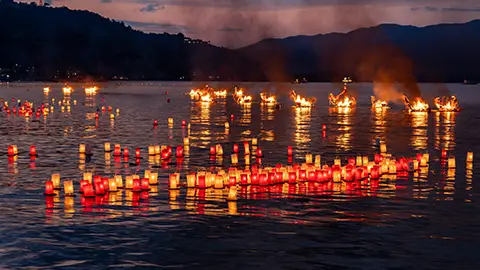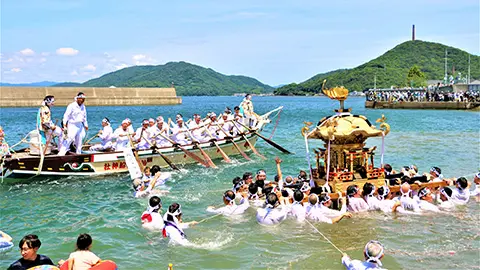VOL.193 JUNE 2024
SUMMER FUN IN JAPAN: SEASIDE FESTIVALS AND EVENTS
Elegant Boat Ritual Featuring Traditional Music Performed on the Sea
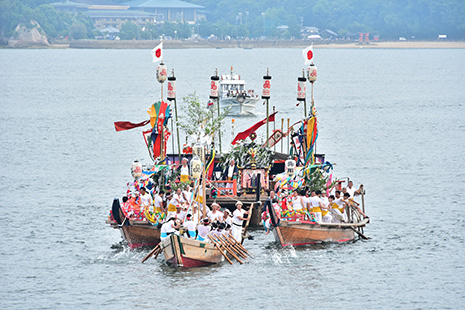
Photo: SHINTANI Koichi
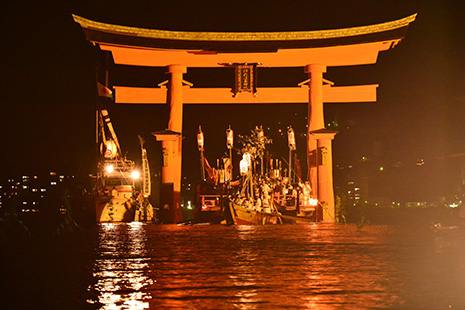
Photo: SHINTANI Koichi
A ritual that replicates the graceful boating traditions of ancient nobility takes place at Itsukushima Shrine in Hatsukaichi City, Hiroshima Prefecture.
Itsukushima Shrine, registered as a UNESCO World Cultural Heritage site in 1996, is located on the island of Itsukushima in Hatsukaichi City, Hiroshima Prefecture. The island, floating in Hiroshima Bay in the western part of the Seto Inland Sea, is more popularly known as ‘Miyajima,’ literally ‘shrine island.’
In the lush green forests of Itsukushima, which extend to the coastline, historical wooden structures lining toward the sea create an impressive landscape. The most splendid ritual at Itsukushima Shrine is the Kangensai. In the 10th to 11th centuries, in the capital at the time, Kyoto, nobles would float boats on ponds and rivers, playing musical instruments in a leisure activity known as kangen*. This occurred more than 800 years ago. Taira no Kiyomori**, who oversaw the construction of Itsukushima Shrine, began conducting the Kangensai ritual to please the gods, adapting this pastime. The event is held annually on the 17th day of the sixth month according to Japan’s old lunisolar calendar, which in 2024 falls on July 22. It takes place from evening until late at night, illuminated by moonlight, where boats glide back and forth on the sea while musicians play kangen music. It is a sight of great elegance and beauty, reminiscent of ancient imperial court rituals being recreated.
We spoke with SUZUKI Naotomo from the Miyajima Tourist Association about the Kangensai Festival. “During the Kangensai Festival, a portable shrine (mikoshi) said to carry the gods of Itsukushima is placed on a ceremonial boat called a goza-bune, which is towed by three smaller boats. Onboard are musicians playing traditional kangen music while circling Itsukushima Shrine and its surrounding auxiliary shrines***,” explains SUZUKI.
“Departing from Itsukushima Shrine in the evening, the goza-bune boat with three smaller boats visit several auxiliary shrines, including Nagahama Shrine, before returning. At around 11pm, they pass through the O-torii, a grand torii gate standing approximately 160 meters offshore from the shrine’s main hall. The highlight of the festival is when each boat circles three times when arriving and departing from the shrine. The most impressive scene occurs during the final return to Itsukushima Shrine, where the ceremonial boat circles closely along the corridor of the shrine’s hall in the narrow masugata****, accompanied by kangen music. This powerful spectacle reaches its climax with hand clapping and cheers from visitors. After completing this ritual, the gods return to the main hall, concluding the festival.”
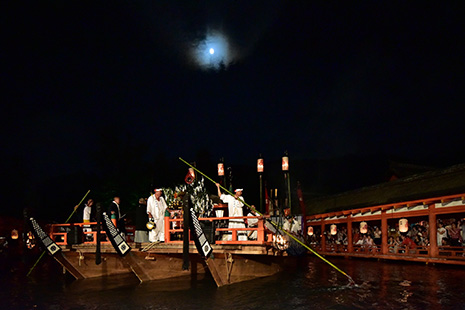
Photo: SHINTANI Koichi
The Kangensai Festival attracts around 10,000 visitors annually, including tourists to Itsukushima. Many visitors come from overseas as well.
“At Nagahama Shrine, where the ceremonial boat circles, there are events such as welcoming the boats with Japanese lanterns called Chochin***** and opportunities for reserved boat rides alongside the ceremonial one. These activities offer participants a more immersive experience of the festival,” explains SUZUKI, while sharing ways to enjoy the event.
This grand and elegant summer ritual unfolding on the Seto Inland Sea until late at night is truly a spectacle. For those who have the opportunity, it is well worth experiencing it firsthand.
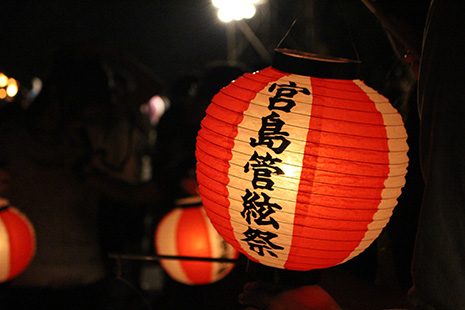
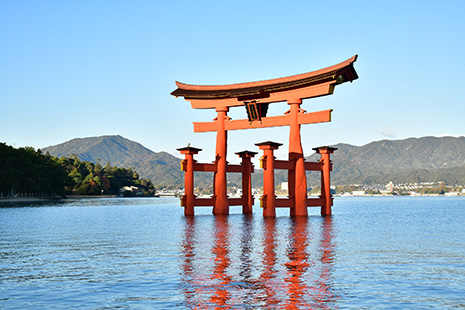
Photo: SHINTANI Koichi
* Kangen is a style of Gagaku music, a traditional form of Japanese court music that includes purely instrumental ensemble performances known as kangen. Gagaku has been passed down since ancient times, incorporating Japan’s own songs such as kagura-uta, and blending elements of ancient music and dance from various Asian mainland countries from around the 5th century, influenced by the introduction of Buddhist culture from China and the Korean Peninsula. Traditional instruments used include the sho, hichiriki, flutes, and other wind instruments, the koto, biwa and other string instruments, as well as the kakko and taiko drums, among others.
** Born in 1118 and died in 1181, this military commander established a warrior government at the end of the 12th century. He was the first samurai to be appointed as the Grand Minister of State, the head of Dajokan, the Grand Council of State, equivalent to today’s Cabinet.
*** Shrines within a shrine complex, associated with the main shrine, dedicated to gods closely connected with the enshrined deity.
**** A square area surrounded by the corridors of the shrine. In 2024, due to repairs on the corridors, scaffolding has been set up, and the boats will circle in a different location.
***** A lighting fixture that uses thin bamboo or wooden frames covered with paper, with candles placed inside for illumination.
By TANAKA Nozomi
Photo: SHINTANI Koichi ; PIXTA
